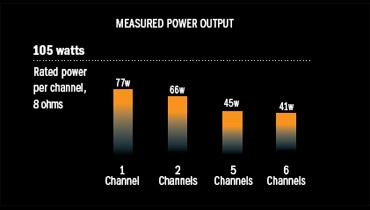Yamaha's Value-Packed Receiver Page 2

DOLBY DIGITAL PERFORMANCE
All data were obtained from various test DVDs using 16-bit dithered test signals, which set limits on measured distorting and noise performance. Reference input level is -20 dBFS, and reference output is 1 watt into 8 ohms. Volume setting for reference level was -3. All level trims at zero, except for subwoofer-related tests, all speakers were set to "large," subwoofer on. All are worst-case figures where applicable.
Output at clipping (1 kHz into 8/4 ohms) 1 channel driven: 77/111* W (18.9/20.5 dBW) 5 channels driven (8 ohms): 45 W (16.5 dBW) 6 channels driven (8 ohms): 41 W (16.1 dBW) Distortion at 1 watt (THD+N, 1 kHz) 8/4 ohms: 0.05/0.05% Noise level (A-wtd): -71.8 dB Excess noise (with sine tone) 16-bit (EN16): 0.6 dB Frequency response: 20 Hz to 20 kHz +0, -0.1 dB * Speaker-impedance setup software-switch at "8-ohm" position. With switch set to "6-ohm," output was limited to about 35 watts (15.4 dBW) in all tests.
MULTICHANNEL PERFORMANCE, ANALOG INPUT
Reference input and output level is 200 mV; volume setting for reference output level was -3.5 dB.
Distortion (THD+N, 1 kHz, 8 ohms): 0.03% Noise level (A-wtd.): -85.3 Frequency response: <10 Hz to 138 kHz +0, -3 dB
STEREO PERFORMANCE, DIGITAL INPUT
Reference level is -20 dBFS; all level trims at zero. Volume setting for reference level was -3.5.
Output at clipping (1 kHz, 8/4 ohms, both channels driven): 66/97 W* (18.2/19.9 dBW)* Distortion at reference level: 0.04% Linearity error (at -90 dBFS): 1.5 dB Noise level (A-wtd): -76.4 dB with 96-kHz/24-bit signals: -80.5 dB Excess noise (with/without sine tone) 16-bit (EN16): 0.35/0.5 dB quasi-20-bit (EN20): 12.5/10.1 dB Noise modulation: 3.3 dB Frequency response: 20 Hz to 20 kHz +0, -0.2 dB with 96-kHz/24-bit signals: 20 Hz to 43 kHz +0 -3 dB *Speaker-impedance setup software-switch at "8-ohm" position. With switch set to "6-ohm," output was limited to about 35 watts (15.4 dBW) in all tests.
BASS-MANAGEMENT PERFORMANCE
Measured results obtained with Dolby Digital test signals.
Subwoofer-output frequency response (crossover set to 80 Hz): 24 dB/octave above -6-dB rolloff point of 80 Hz High-pass-filter frequency response (crossover set to 80 Hz): 12 dB/octave below -3-dB rolloff point of 80 Hz Maximum unclipped subwoofer output (trim at 0): 6.4v Subwoofer distortion (from 6-channel, 30-Hz, 0-dBFS signal; subwoofer trim set to 0): 0.04% Crossover consistency: bass crossover frequency and slope were consistent for all sources and formats Signal-format consistency: consistent for all applicable formats Speaker size selection: all channels can be set to "small" Speaker-distance compensation: available for all main channels.
In absolute terms, Yamaha's RX-V863's test bench results are fine, but they do fall a bit short in a couple areas as compared to a majority of recent similar-price receivers. The unit failed to meet its 105-watt power specification in any test, and could not quite muster 50 watts all around with five (or more) channels driven. (But note that this is nevertheless only a shortfall of 2 or 3 real-world dB - hardly a hanging matter.) I also found that the RX-V863's "6-ohm" setup mode restricted power even further, to about half of "8-ohm" levels. Noise and distortion were generally quite good, but a limited improvement on 96/24 PCM, and somewhat high noise-modulation results, suggest a bit of digital-domain inaccuracy at the very lowest levels. (I did not notice audible noise-mod effects in real-world listening, but could detect them on a custom, exaggerated fade-to-silence-and-back test signal via headphones.) On the other hand, the RX-V863's frequency response, distortion, and crossover accuracy were consistently excellent.
- Log in or register to post comments




















































